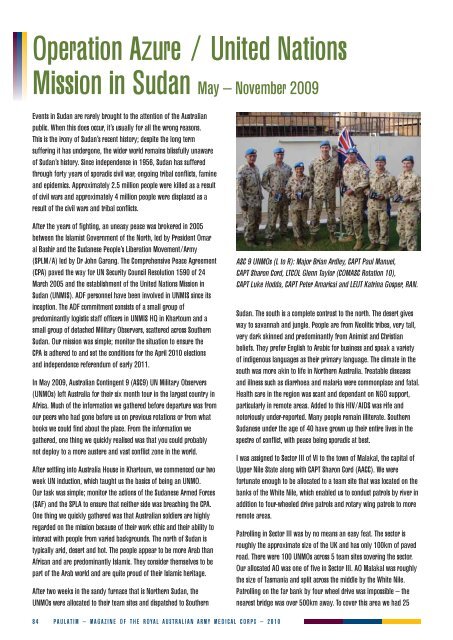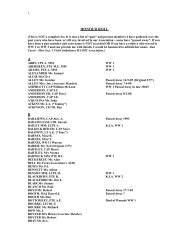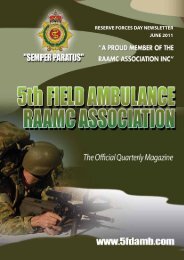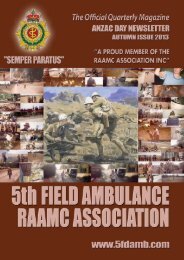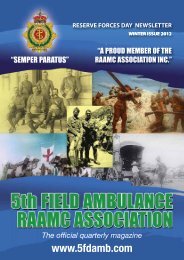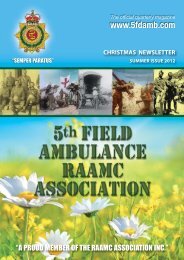2010 Paulatim Magazine - RAAMC Association
2010 Paulatim Magazine - RAAMC Association
2010 Paulatim Magazine - RAAMC Association
You also want an ePaper? Increase the reach of your titles
YUMPU automatically turns print PDFs into web optimized ePapers that Google loves.
Operation Azure / United Nations<br />
Mission in Sudan May – November 2009<br />
Events in Sudan are rarely brought to the attention of the Australian<br />
public. When this does occur, it’s usually for all the wrong reasons.<br />
This is the irony of Sudan’s recent history; despite the long term<br />
suffering it has undergone, the wider world remains blissfully unaware<br />
of Sudan’s history. Since independence in 1956, Sudan has suffered<br />
through forty years of sporadic civil war, ongoing tribal conflicts, famine<br />
and epidemics. Approximately 2.5 million people were killed as a result<br />
of civil wars and approximately 4 million people were displaced as a<br />
result of the civil wars and tribal conflicts.<br />
After the years of fighting, an uneasy peace was brokered in 2005<br />
between the Islamist Government of the North, led by President Omar<br />
al Bashir and the Sudanese People’s Liberation Movement/Army<br />
(SPLM/A) led by Dr John Garang. The Comprehensive Peace Agreement<br />
(CPA) paved the way for UN Security Council Resolution 1590 of 24<br />
March 2005 and the establishment of the United Nations Mission in<br />
Sudan (UNMIS). ADF personnel have been involved in UNMIS since its<br />
inception. The ADF commitment consists of a small group of<br />
predominantly logistic staff officers in UNMIS HQ in Khartoum and a<br />
small group of detached Military Observers, scattered across Southern<br />
Sudan. Our mission was simple; monitor the situation to ensure the<br />
CPA is adhered to and set the conditions for the April <strong>2010</strong> elections<br />
and independence referendum of early 2011.<br />
In May 2009, Australian Contingent 9 (ASC9) UN Military Observers<br />
(UNMOs) left Australia for their six month tour in the largest country in<br />
Africa. Much of the information we gathered before departure was from<br />
our peers who had gone before us on previous rotations or from what<br />
books we could find about the place. From the information we<br />
gathered, one thing we quickly realised was that you could probably<br />
not deploy to a more austere and vast conflict zone in the world.<br />
After settling into Australia House in Khartoum, we commenced our two<br />
week UN induction, which taught us the basics of being an UNMO.<br />
Our task was simple; monitor the actions of the Sudanese Armed Forces<br />
(SAF) and the SPLA to ensure that neither side was breaching the CPA.<br />
One thing we quickly gathered was that Australian soldiers are highly<br />
regarded on the mission because of their work ethic and their ability to<br />
interact with people from varied backgrounds. The north of Sudan is<br />
typically arid, desert and hot. The people appear to be more Arab than<br />
African and are predominantly Islamic. They consider themselves to be<br />
part of the Arab world and are quite proud of their Islamic heritage.<br />
After two weeks in the sandy furnace that is Northern Sudan, the<br />
UNMOs were allocated to their team sites and dispatched to Southern<br />
ASC 9 UNMOs (L to R): Major Brian Ardley, CAPT Paul Manuel,<br />
CAPT Sharon Cord, LTCOL Glenn Taylor (COMASC Rotation 10),<br />
CAPT Luke Hodda, CAPT Peter Amaricai and LEUT Katrina Gosper, RAN.<br />
Sudan. The south is a complete contrast to the north. The desert gives<br />
way to savannah and jungle. People are from Neolitic tribes, very tall,<br />
very dark skinned and predominantly from Animist and Christian<br />
beliefs. They prefer English to Arabic for business and speak a variety<br />
of indigenous languages as their primary language. The climate in the<br />
south was more akin to life in Northern Australia. Treatable diseases<br />
and illness such as diarrhoea and malaria were commonplace and fatal.<br />
Health care in the region was scant and dependant on NGO support,<br />
particularly in remote areas. Added to this HIV/AIDS was rife and<br />
notoriously under-reported. Many people remain illiterate. Southern<br />
Sudanese under the age of 40 have grown up their entire lives in the<br />
spectre of conflict, with peace being sporadic at best.<br />
I was assigned to Sector III of VI to the town of Malakal, the capital of<br />
Upper Nile State along with CAPT Sharon Cord (AACC). We were<br />
fortunate enough to be allocated to a team site that was located on the<br />
banks of the White Nile, which enabled us to conduct patrols by river in<br />
addition to four-wheeled drive patrols and rotary wing patrols to more<br />
remote areas.<br />
Patrolling in Sector III was by no means an easy feat. The sector is<br />
roughly the approximate size of the UK and has only 100km of paved<br />
road. There were 100 UNMOs across 5 team sites covering the sector.<br />
Our allocated AO was one of five in Sector III. AO Malakal was roughly<br />
the size of Tasmania and split across the middle by the White Nile.<br />
Patrolling on the far bank by four wheel drive was impossible – the<br />
nearest bridge was over 500km away. To cover this area we had 25<br />
8 4 P A U L AT I M – M A GAZINE O F T HE R OYA L A U S T R A L I A N A R M Y M E DICAL C O R P S – 2 0 1 0


